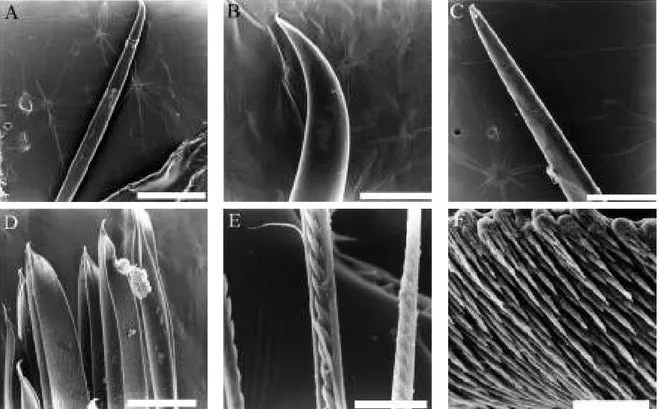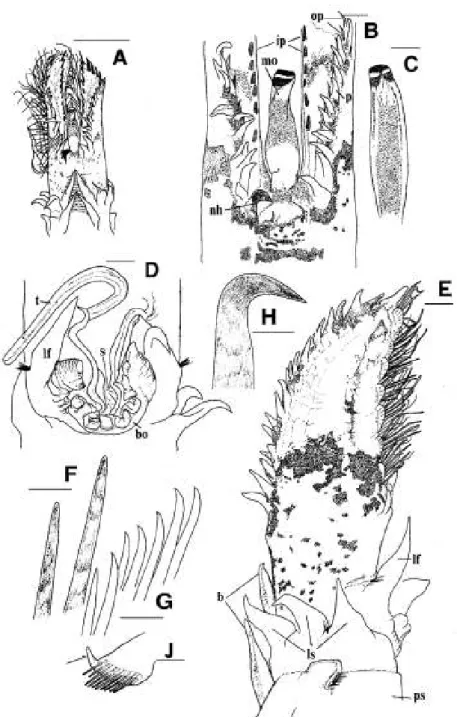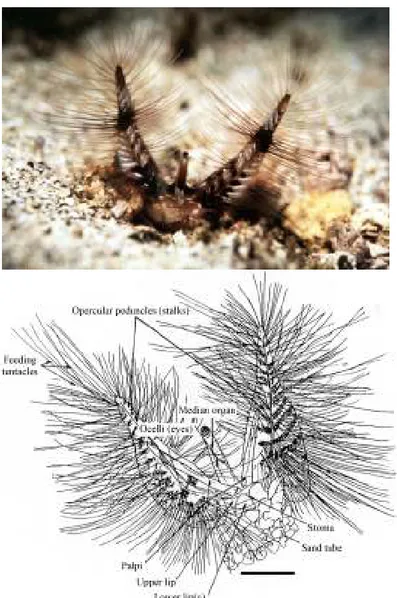A NEW SPECIES OF SHALLOW WATER SABELLARIIDAE (ANNELIDA:
POLYCHAETA) FROM MADEIRA ISLAND, PORTUGAL, AND CANARY
ISLANDS, SPAIN
EIJIROH NISHI & JORGE NÚÑEZ
NISHI, E. & J. Núñez 1999. A new species of shallow water Sabellariidae (Annelida: Polychaeta) from Madeira Island, Portugal, and Canary Islands, Spain. Arquipélago. Life and Marine Sciences 17A: 37-42. Ponta Delgada. ISSN 0873-4704.
A new species of Sabellariidae (Annelida, Polychaeta), Lygdamis wirtzi, is described, based on material from Madeira and Canary Islands, northeastern Atlantic Ocean. The specimens were collected from sandy bottom at 7 to 14 m depth. The new species is characterised by the shape of the inner and outer paleae and of the nuchal hooks. The feeding position of living animals is described.
NISHI, E. & J. NÚÑEZ 1999. Uma nova espécie de Sabellariidae (Annelida: Polychaeta) de águas pouco profundas da Ilha da Madeira, Portugal, e Ilhas das Canárias, Espanha. Arquipélago. Ciências Biológicas e Marinhas 17A: 37-42. Ponta Delgada. ISSN 0873-4704.
A descrição de uma nova espécie de Sabellariidae (Annelida: Polychaeta), Lygdamis wirtzi, é feita, baseada em material da Madeira e Ilhas Canárias, Oceano Atlântico Nordeste. Os espécimes foram recolhidos em fundo arenoso numa profundidade entre os 7 e 14 metros. A nova espécie é caracterizada pela forma do paleae interior e exterior e pelos ganchos nucais. A posição de alimentação do organismo vivo é descrita.
Eijiroh Nishi, Coastal Museum of Natural History, Yoshio, Katsuura, Chiba 299-7242, Japan - Present Address: Manazuru Marine Laboratory for Science Education, Yokohama National University, Iwa, Manazuru, Kanagawa 290-02, Japan. Jorge Núñez, Universidad de La Laguna, Facultad de Biologia, Departamento de Biologia Animal, ES-38206 La Laguna, Tenerife, Spain. e-mail: cr2e-ns@asahi-net.or.jp
INTRODUCTION
Sand tube- and reef forming polychaetous annelids of the family Sabellariidae have attracted the attention of a number of scientists but their taxonomy had been poorly known before the revision of the family by KIRTLEY (1994). After this monograph had been published, a few additional species were described from the Pacific Ocean (e.g., LECHAPT & KIRTLEY 1996, 1998; NISHI & KIRTLEY 1999). Dr. Peter Wirtz sent some material of Lygdamis, which he collected at Madeira Island to David Kirtley, who replied
material belonged to a new species, which he planned to describe as L. wirtzi. In July 1997, Dr. Kirtley unfortunately died. Dr. Wirtz kindly sent me fresh material of Madeiran Lygdamis, which we here describe. The second author provided additional materials during the survey of Canary Islands, Salvage Islands, and Western Sahara.
MATERIALS AND METHODS
Specimens were collected by Dr. Peter Wirtz and Mr. J. Escatler using SCUBA gear, gently digging the animals out from sandy bottom at Madeira
sand, in front of Hotel Galomar, Caniço, in December, 1998, and 7 to 10 m depth at Canary Islands, 1995. Three specimens were anaesthetised in a MgCl solution and stored in 70% ethanol. The material was then sent to Coastal Museum and Natural History, Katsuura, Japan, it was examined and dissected under a light microscope. Paleae and setae were observed under scanning electron microscopy (SEM). For the SEM observation, paleae and parapodia were transferred to 80, 90, 95, 99, 100% ethanol, air-dried, coated with paradium and Pt, and finally
viewed on a Hitachi S-800 SEM. The specimens are now deposited in the Coastal Museum of Natural History (CMNH-ZW) and Museum of Sciences of Tenerife (MCT).
RESULTS
Family Sabellariidae Johnston, 1865 Subfamily Lygdaminae Kirtley, 1994 Genus Lygdamis Kinberg, 1867 Lygdamis wirtzi new species
Fig. 2. Lygdamis wirtzi SEM photos of paleae and chaetae. A-B, inner palea. C, outer palea. D, paleae from parathoracic 2nd segment. E, abdominal chaetae. F, abdominal uncini. Scale shows 750 µm (A), 100 µm (B), 500 µm (C) 150 µm (D), 30 µm (E), 25 µm (F).
Fig. 1. Lygdamis wirtzi. A, dorsal view of crown and anterior thorax of holotype. B, dorsal view of middle part of crown showing median organ (mo), rows of paleae (ip, inner palea; op, outer palea), left nuchal hook (nh; lacking right hook) and papillae (p). C, ventral view of median organ. D, ventral view of mouth, tube-building organ (bo), prostomial tentacles (t), stoma (s) and anterior thoracic segments (lf, lobe of first setigerous segment). E, right view of crown and anterior thorax of holotype showing a conical lobe with a fascicle of chaetae on first setiger (lf), three conical lobe on second setinger (is), branchia (b), parathoracic segment (ps) and dotted pigmentation on opercular
Fig. 3. Lygdamis wirtzi. The two opercular lobes in the feeding position: upper, colour photo of living animal taken by Peter Wirtz; lower, figure drawn by David W. Kirtley.
MATERIAL EXAMINED
Holotype, CMNH-ZW-30, Madeira Island, 14 m depth, at the margin of rock and sand, in front of Hotel Galomar, Caniço, December 1998, collected by Dr. Peter Wirtz. Two paratypes, -ZW-31 and 32, same data as holotype. Two paratypes, CMNH-ZW-51 and 52, and one paratype, MCT-XXX, same data as holotype. Three paratypes, MCT-XXX and -XXX, Canary Island, Tenerife, 7 m depth, sandy bottom with stones, part of the tube under stones, Teresitas Beach, San Andres, September 1994, collected by J. Escatller; one paratype, NCT-XXX, Canary Islands,
Tenerife, 10 m depth, stones with gravel, Palm-Mar, Adeje, December 1995, collected by J. Escatller.
DESCRIPTION
Holotype and paratypes complete; total length 95 mm excluding cauda, 100 mm including cauda (holotype), thoracic diameter 4 mm, abdominal diameter 4-5 mm. Anterior end of opercular stalk completely divided into bilaterally symmetrical lobes (Fig. 1A, 3 lower). Opercular paleae of two kinds, in curved, dorso-ventral rows (Fig. 1F, G). Outer paleae 28-43 in number, 2 mm long, protruding 0.5-1 mm from lobe, semi-transparent, slender, smooth-sided, flattened in cross section, with curved tips (Fig. 1G, 2B-C); inner paleae 18-28 in number, 3-4 mm long, protruding 0.5-2 mm from lobe, light brown, smooth, terminating in blunt point (Fig. 1F, 2A). A series of 30-35 conical palpi along anterior margin of each lobe (Fig. 1A, B). Falcate dorsal nuchal hooks, tips recurved inward toward dorsal midline (Fig. 1H). With well-developed median organ, about half-length of lobe, arising from dorsal sagittal suture between opercular lobes (Fig. 1B, C). Top of median organ with dark brown with white line, middle part with light brown, lower part pale white. Ventrally middle part light brown; with a black line on each side distally (Fig. 1C). A pair of ocelli on ventral lower part of median organ (Fig. 3 lower) not discernible in fixed materials (Fig. 1C).
Over 100 pairs of filiform feeding tentacles on ventral margins of inner sides of opercular peduncle, outer row tentacle whitish with a line of brown slit, inner row light brown. A pair of prehensile prostomial tentacles, nearly same length of operculum, arising from anterior margin of upper lip of stoma (Fig. 1D). Large U-shaped building organ with small papillae on lateral margins, and on each side a large conical lobe, each with a fascicle of short, finely serrate slender chaetae (Fig. 1D, E). Second setigerous segment with three conical lobes on each side and ventral one with a fascicle of slender finely serrete chaetae dorsal to the middle lobe (Fig. 1E). Four parathoracic segments with tiny cirri on distal margin of setigerous notopodial sheaves (Fig. 1J); 8-10 paired, stout setae with lanceolate distal tips (Fig. 2D) and spinous chaetae. Neuropodial chaetae similar but smaller in size and fewer in number. Dorsal branchiae well developed on parathoracic segments (Fig. 1A) and first to 10th abdominal segments, diminished in size on 11-14th segments, absent on posterior ones. Abdominal segments, 60 in holotype, with bundles of long, spiny neurosetae (Fig. 2E) and uncinigerous notopodial tori (Fig. 2F). Tube constructed with coarse sand particles (Fig. 3).
ETYMOLOGY
The new species is named after Dr. Peter Wirtz, who collected the material from Madeira.
ECOLOGY AND FEEDING POSITION
According to Dr. Wirtz, the species is common around Madeira Island, from about 5 m depth down to at least 35 m depth. It commonly occurs in sandy substrate close to rock or gravel, the final 5 cm of the tube (which may be more than 15 cm long) being firmly attached to hard substrate. Dr. Wirtz took numerous photos of the new species in the field and some of these photos (e.g. Fig. 3) show the posture of feeding and the position of some of the appendages of the living animal. The worm holds the crown towards the water current, with the longitudinal axis of the worm at a small angle. The median organ and the
feeding tentacles are directed to the water current or slightly anteriorly (Fig. 3). Not all the worms in the same area show the same direction of the feeding crown (see figures of WIRTZ 1995, 1998).
REMARKS
Species of Lygdamis that have similar outer paleae with smoth-sided curved distal tips differ in various ways. Those of L. curvatus and L. ehlersi are blunt-tipped and only slightly curved: those of L. gibbsi have a more gentle curved over a longer arc (and very different nuchal hooks); those of L. laevispinia and L. nesiotes have a sharper curve with a very small sigmoidal tip and those of L. rayrobertsi have less curvature and a very small sigmoidal tips. Furthermore all these species have nuchal hooks with sharper and more reflexed curve.
The only known species that might overlap geographically with L. wirtzi is Lygdamis muratus. It differs from L. wirtzi in that the outer paleae of L. muratus are almost straight, the nuchal hooks are more curved and the lateral lobes on the second setinger are very different in having irregular distal margins and in being fused basely to form a collar-like structure. Those of L. wirtzi are triangular in shape and well separated.
KIRTLEY (1994) suggested that the shape and coloration patterns of the median organ have significant diagnostic importance, particularly in live materials (p. 116). We therefore report here on the shape and coloration of the median organ of the new species. As this has not yet been done for other species, no comparisons can be made.
Dr. Wirtz has taken similar photographs of Lygdamis species at the Canary Islands and at the Cape Verde Islands, and the second author observed similar one at Salvage Islands, but without a study of the morphology of specimens the species-names of these species cannot be determined.
ACKNOWLEDGEMENTS
Firstly we would like to dedicate this work to the memory of David Kirtley, who studied Madeiran
before the completion of this work. The first author (E. N.) has been working with him on Japanese Sabellariidae for several years and some results are already published in NISHI & KIRTLEY (1999). Secondly we are grateful to Dr. Peter Wirtz, who sent us fresh material and field colour photos of polychaetes and gave us a chance to publish this paper. We acknowledge anonymous referees for their useful suggestions on the manuscript. Finally we acknowledge the staff of the Coastal Museum of Natural History for their encouragement and careful advice on invertebrate biology.
REFERENCES
LECHAPT, J.-P. & D.W. KIRTLEY 1996. Bathysabellaria spinifera (Polychaeta: Sabellariidae), a new species from deep water off New Caledonia, Southwest
Pacific Ocean. Proceedings of the Biological Society of Washington 109: 560-574.
LECHAPT, J.-P. & D.W. KIRTLEY 1998. New species of bathyal and abyssal Sabellariidae (Annelida: Polychaeta) from near New Caledonia (Southwest Pacific Ocean). Proceedings of the Biological Society of Washington 114(4): 807-822.
KIRTLEY, D.W. 1994. A review and taxonomic revision of the family Sabellariidae Johnston, 1865 (Annelida: Polychaeta). Sabecon Press Science Series, Florida. 223 pp.
NISHI, E. & D.W. KIRTLEY 1999. Three new species of Sabellariidae from Japan. Natural History Research 5 (2): 93-105.
WIRTZ, P. 1995. Underwater Guide Madeira, Canary Islands, Azores Invertebrates. Naglschmid Verlag, Stuttgart. 247 pp.
WIRTZ, P. 1998. Der Teufelswurm. Aquarien und Terrarien Zeitschrift (DATZ) 51 (3): 197.


